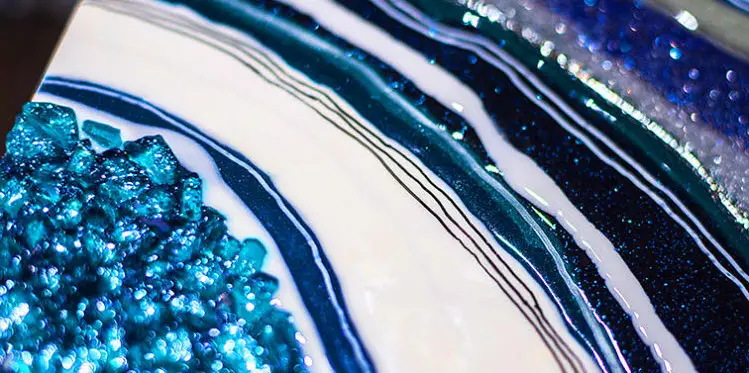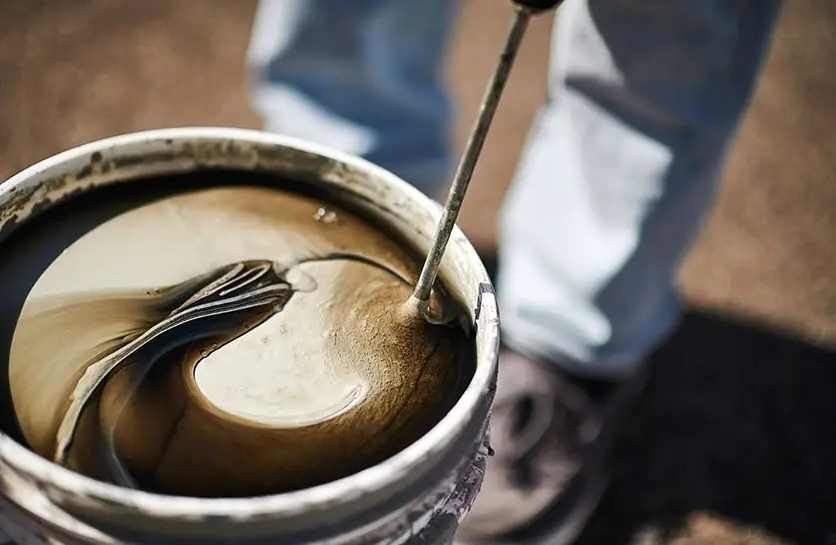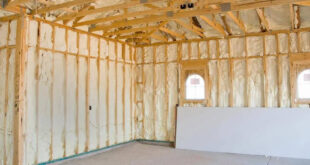
Page Contents
Optimal storage of the original containers
Storage / Shelf life: In unopened original containers, dark and above 15 °C / at least 2-3 years
Especially immediately before application, resin/hardener should be stored at room temperature (20 – 25 °C) for at least 12 hours.
Only use resin/hardener as long as the minimum durability date has not yet been exceeded (resins are usually less critical than hardeners in this respect).
Opening the original containers and removing the components
When original containers are opened, the air humidity should be as low as possible ( ≤ 65% is ideal). Especially the hardeners tend to react with air humidity and then lose quality the longer or more often the contact takes place. The more often a container is opened, the more often it comes into contact with atmospheric oxygen and moisture and other components present in the ambient air. Especially the hardeners react with all organic components in the air. Depending on temperature and reactivity, the reaction is more or less rapid and has a more or less significant effect on the quality of the hardener.
When removing the components, care must also be taken not to contaminate the epoxy resin/hardener with dirty tools (brushes, stirrers, mixers)
Processing
During application, the temperature of the epoxy resin systems and the ambient temperature should ideally be around 20 °C.
Lower or higher temperatures can make processing difficult or impossible. Among other things, however, this also depends on the epoxy resin system used. Special epoxy resin systems can be processed from 5 degrees upwards. Others require processing temperatures well above 25 degrees.
Even during processing, the air humidity should be as low as possible (≤ 65% is ideal) and the ambient air must not be contaminated with foreign substances.
Air contaminated with foreign substances can also have a separating effect and affect the bond between two layers of epoxy or laminate.
More about the different epoxy resins and their applications you can find in the in-depth guide on fluid-painting.com.
Mixing of resin and hardener

Resin and hardener must be dosed as accurately as possible (+/-2 parts), preferably by weight, only in exceptional cases by volume. The quantities should not be too small because of the corresponding tolerances (the smaller the quantity of resin/hardener used, the smaller the tolerance). Ideal are quantities of > 50 g resin + corresponding quantity of hardener, weighed with a suitable digital scale and mixed in a suitable mixing vessel (to be found in the R&G-Shop)
The mixing of the components must be as thorough as possible. Here too, it is advantageous not to use too small a batch, as this can lead to excess resin or hardener on the walls of the mixing vessels. Practice shows that faulty hardenings increase the smaller the quantity mixed. Important: Adding more hardener than prescribed does not result in faster curing, but only in poorer properties. Likewise, the working time cannot be extended by adding less hardener. In case of large deviations, curing may not take place! Further information can be found elsewhere in our WIKI and also in the processing instructions, which are enclosed in the working packages of the epoxy resin systems.
Processing time (pot life)
There are various methods for determining the processing time. The most common is the use of a gel timer to determine pot life and gelling time.
You can use a mixing vessel (mixing cup) with a high form. The pot life specifications should be regarded as guide values, as various influences can lead to deviations.
Curing – influence of air humidity
During curing, the environmental conditions should be ideal until the epoxy resin system is fully cured. Especially when using epoxy resin systems that are to cure at room temperature, temperature, humidity etc. must not fluctuate over a longer period of time. Constant conditions until complete curing are very important to achieve the highest possible component quality.
The ideal humidity is ≤ 65%, the less the better. The room temperature in both cases was about 22 degrees Celsius
The substrate on which the epoxy resin system is applied
The substrate, e.g. a negative mould, regardless of the material used, should generally have at least the same temperature as the room temperature, i.e. about 20-25 degrees (this varies with special epoxy resin systems, special applications).
If a bond is to be made with the substrate, its surface must be free of any contamination, free of all components that could have a separating effect (see our post on how to make an epoxy table yourself).
If no bond is to be made with the substrate, e.g. in mould making, then care must be taken to ensure that the release agent is applied correctly.
If release agents are processed improperly, this can result in the curing of the epoxy resin system (for example, because solvents contained in the release agent have not completely evaporated). Materials such as petroleum jelly or grease, which contaminate the epoxy resin system due to their consistency, can also lead to incorrect curing.
Further processing information
Stirring
Resin components containing fillers (gelcoat, mould resin) should be stirred thoroughly before use. Heating in a water bath/microwave facilitates homogenisation. Important: Fillers settle and segregate!
Mixing
The mixing of the resin/hardener components must be done very carefully. The mixing time should be at least 60 seconds. Use a sharp-edged stirring spatula to allow stripping.
Important: Great attention must be paid to the cup rim and bottom. Repeated wiping with a wooden stirrer reliably prevents uneven mixing!
Processing conditions
Temperature: The optimum processing temperature is approx. 20 °C. A temperature increase of 10 °C halves the pot life/doubles the reactivity.
Important: At higher processing temperatures, especially with highly reactive systems (short pot life/less than 40 min.), no larger quantities should be mixed. As the heat dissipation from the mixing vessel is very low, the vessel contents are heated very quickly by the reaction heat. This can result in temperatures above 200 °C, at which the resin mass boils away under strong smoke development. This also applies to large-volume grouting of highly reactive systems.
Air humidity: The air humidity during processing should not exceed 65 % relative humidity. Moist fillers can also have a negative influence on curing.
Important: PU resins react very strongly with the air or ambient humidity when foaming (humidity also limits the shelf life). EP resins are accelerated by moisture!
Fillers and additives
The properties of epoxy resins can be improved by various additives. Pigments are used for colouring, fillers for increasing the mechanical strength of the moulding material.
We recommend the use of ready-to-use pigment colour pastes (epoxy colour pastes) which can be mixed in easily and without clumping.
Fillers are for example glass chips, thixotropic agents, cotton flocks and glass bubbles. Fillers can be spherical, rod or platelet-shaped.
The stirring
Small quantities up to 500 g should be stirred thoroughly by hand for 1 – 2 minutes. We recommend wooden stirring spatulas.
Larger amounts can only be mixed by means of a mixing propeller (stirrer with plastic propeller or stirrer with metal propeller) and a drill. Despite mechanical, intensive mixing of the components, the bottom and walls of the mixing vessel should be scraped with a clean wooden slat.
Tools and mixing vessels
The vessels, equipment and tools used for resin and hardener must be clean. There must also be no oil, wax or grease film on the parts. Tools used to handle release agents must be kept separate from those used for resin and hardener. To further eliminate the risk of contamination, resin, hardener or the mixture should be covered.
 A Very Cozy Home Home Decor Tips and Ideas
A Very Cozy Home Home Decor Tips and Ideas 